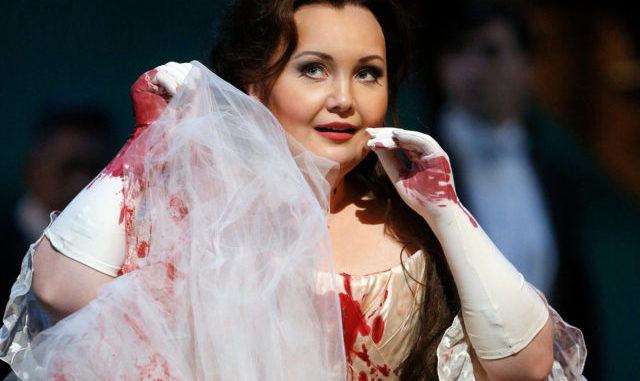
Ever since its première at the Teatro San Carlo on Sept. 26, 1835, “Lucia di Lammermoor” has held a firm position in the standard opera repertoire. For one thing, it’s Gaetano Donizetti’s greatest musical masterpiece, chock full of brilliant pieces from beginning to end, all brightly colored by the composer’s creative orchestration. For another, the text was very cleverly adapted by Salvatore Cammarano, whom Verdi declared to be the best librettist in Italy, from the 1819 novel, “The Bride of Lammermoor” by Sir Walter Scott, himself no slouch when it came to spinning a tale or turning a phrase.
As great as the music is in this opera, we will touch on only two numbers for now. When we actually review a live Lyric Opera November performance of “Lucia” we will discuss some of the work’s other fine arias and ensembles. But I don’t believe it’s possible to have any general examination of “Lucia” without looking at “Ardon gl’incensi” (the Mad Scene) and “Chi mi frena in tal momento” (the Sextet).
Mad Scenes were plentiful and popular in the Golden Bel Canto Age. It is not hard to understand the appeal of such scenes — at any time. Even in real life someone having a mental meltdown is an immediate object of interest, even gripping fascination, to say the least. The Mad Scene from “Lucia” is the most famous because it was the best. But it was also very typical of the genre — and no doubt one of the main reasons why the opera succeeded.
For a fine novelist like Sir Walter Scott, an event like this can be a culmination of finely woven literary nuances. In the context of an opera, however, it is an acutely dramatic event on three levels. First you have the contribution of the dramatist (in the case of “Lucia,” Cammarano), who has not only invented a fictitious character losing her marbles, but has set up the scene by anticipating it with earlier lines and situations. Then all of this is intensely magnified by the music of Donizetti that is not only beautiful, but somehow captures that other-worldly feeling of insanity. Finally there is the soprano, the prima donna (in the première, Fanny Tacchinardi-Persiani), who realizes that third and perhaps most important level of drama, by acting out this psychological dissolution and singing some of the most technically difficult music ever written.
Regarding the performance of opera I have always believed, and still believe, that opera is (or should be) a singer’s art. But the genius of the creation of a work that will stand the pitiless test of time is that of the composer and the librettist. In performing “Ardon gli’incensi” from “Lucia’s” Act 3 singers will undoubtedly take liberties with the tempos or add embellishments and ornaments or other show-off stuff here and there — and Donizetti expected this, as did other composers with their arias. To accommodate this natural tendency of divas he wrote out plenty of crowd-pleasing coloratura passages, plus he composed three separate cadenzas at the end of the aria. (Some singers use other cadenzas!) Naturally the soloists and the virtuoso flute accompanists (replacing Donizetti’s original glass harmonica) are wildly applauded.
But what the singers can not improvise on is the structure of the scene, or those numerous anticipatory musical hints of it heard previously, and these are the main things that make it so great. By using some of the exact same music heard in the first-act duet of Lucia and Edgardo and that of Lucia when she sees the “fantasma,” Donizetti makes it very clear that the woman is going mad. It does not even matter so much that her white bridal clothes are smeared with blood. Thanks to this creative genius an outstanding coloratura can make a performance of this scene a memorable event for a member of an audience.
If Donizetti had composed nothing else other than “Chi mi frena in tal momento,” the Great Sextet from Act 2 of “Lucia di Lammermoor,” he would still have to be regarded as one of the best composers of all time. The piece is a sublime, unforgettable melody and an intricate, dazzling vocal ensemble worthy of Bach or Mozart and it in fact influenced Verdi consciously when he penned his great quartet in Act 4 of “Rigoletto.”
Interestingly the Sextet, which sets up the “pezzo concertante” finale of Act 2, is triggered by a dramatic event similar to one that is precursor to another Act 2 finale, this one in Verdi’s “Il trovatore” when Manrico suddenly appears, stunning everyone into momentary silence. (Of course it was Salvatore Cammarano who wrote that libretto, too!) In “Lucia,” the heroine, finally beaten down by her brother, the baritone Enrico, has just signed the wedding contract with the rich Arturo Bucklaw when the tenor, Edgardo, Lucia’s presumed lost lover enters dramatically. After a moment of stunned silence (as in “Trovatore”) and a two-bar syncopated pizzicato intro, the Sextet begins.
Initially the tenor has the melody in close harmony with the baritone singing another melodic line to different words. When the basic sixteen-bar melody is finished, the soprano takes up the melody and takes command of the ensemble from there to the end. Although the number is a sextet, the vocal heavy lifting is done by the three principals — Lucia the soprano, Edgardo the tenor and Enrico the baritone. They are supported to greater or lesser extent by Raimondo, a bass, Alisa, a mezzo and Arturo, a second tenor.
The Mad Scene may be the most famous number in “Lucia di Lammermoor” but very few can hum its prime melody, unlike that of the Sextet, which is incredibly popular, even today. As recently as 2006 Martin Scorsese used it extensively in his film, “The Departed,” where it seemed to be associated directly with the Frank Costello character, although how someone like that could ever be in to Donizetti doesn’t make too much sense. In this film, sometimes the melody of “Chi mi frena” is simply whistled, at others there is a full-blown vocal/orchestral soundtrack playing in the background.
I don’t believe that Scorsese needed his arm twisted to use this music in “The Departed’s” soundtrack for perhaps an allusion to murder or evil. Again, the Sextet is so well-known that anyone might use it for any reason. But the director could have gotten his inspiration from the 1932 film “Scarface,” with Paul Muni. In this film Muni, who plays a Capone-like gangster, himself whistles the melody of “Chi mi frena” only twice — before he personally assassinates his two biggest rivals. Thus the melody is eerily used very much as it is in the opera, as a harbinger of murder — a much more appropriate use of the music, I think, than in the more recent film.
Of course the Sextet is used repeatedly in commercials and other soundtracks, so don’t be surprised the next time you hear it in a film or on TV. True greatness transcends time.
There are some things about “Lucia di Lammermoor” that make it the quintessential Romantic opera. I suspect that even iconoclastic academics, who are now teaching that the Romantic Era (as far as the visual and literary arts are concerned) ended in about 1840, will agree with me. What they won’t agree with me is that Gustave Flaubert (1821-1880) was an excellent Romantic novelist and his best Romantic novel (which the academics now label “early modern realism”) is his 1857 “Madame Bovary.” I will suspend the debate about the temporal borders of Romanticism for now, but we will turn briefly to Flaubert’s signature novel to show what a cultural icon “Lucia” had become in such a short time.
In Chapter 15, Part 2 of “Madame Bovary” Emma attends the opera at Rouen with her husband after one more uneasy reconciliation. The opera that is staged is “Lucia di Lammermoor,” and as Emma watches, she identifies with Lucia, falls madly in love with the tenor, and fantasizes about rambling around the world making wild love with him. This is no coincidence. An outstanding author, Flaubert knew exactly the vehicle to use for Emma’s auto-projection — an opera and a mad character that every reader at least had heard of. Now the very common Romantic theme of obsessive-love-leading-to-death-and-destruction would be indelibly stamped in his readers’ minds if it hadn’t been already. But the only way that this could be an effective device were if the opera were a very special one indeed. And “Lucia” is certainly that!
We in Chicago are truly blessed that a big-time opera company like the Lyric is presenting two other gems of the Romantic Era this season — “Norma” and “Carmen.” We will pick up our discussion of Romanticism when we look at these two masterpieces a little later.
The 2016 Lyric Opera production of “Lucia di Lammermoor” will feature the following:
Lucia — Albina Shagimuratova
Edgardo — Piotr Beczala
Enrico — Quinn Kelsey
Conductor — Enrique Mazzola
Director — Graham Vick
Set Designer — Paul Brown
The performance dates are October 25, 19, 23, 26 and 29, and November 1 and 6.
For tickets or more info visit www.lyricopera.org or call 312-827-5600
 Fra Noi Embrace Your Inner Italian
Fra Noi Embrace Your Inner Italian







Let’s not forget Lucia’s amazing final scene! Sometimes cut in live performances, it is a tour de force for the tenor, beginning with a very beautiful recitative–“Tombe degli’avi miei, l’ultimo avanzo d’una stirpe infelice….”–and continuing with wonderful melodies.